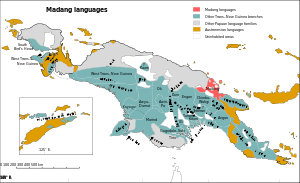Madang languages
| Madang | |
|---|---|
| Madang–Adelbert Range | |
| Geographic distribution: | New Guinea |
| Linguistic classification: |
|
| Subdivisions: | |
| Glottolog: | mada1298[1] |
|
Map: The Madang languages of New Guinea
The Madang languages
Other Trans–New Guinea languages
Other Papuan languages
Austronesian languages
Uninhabited | |
The Madang or Madang–Adelbert Range languages are the largest family of Trans–New Guinea languages (TNG). It was classified as Trans–New Guinea by Stephen Wurm, followed by Malcolm Ross. William A. Foley concurs that it is "highly likely" that the Madang languages are part of TNG, although the pronouns, the usual basis for classification in TNG, have been replaced in Madang.
The family is named after Madang Province and the Adelbert Range.
History
Sidney Herbert Ray identified the Rai Coast family in 1919. In 1951 these were linked with the Mabuso languages by Arthur Capell to create his Madang family. John Z'graggen (1971, 1975) expanded Madang to languages of the Adelbert Range and renamed the family Madang–Adelbert Range, and Wurm (1975) adopted this as a branch of his Trans–New Guinea phylum. For the most part, Ross's (2005) Madang family includes the same languages as Z'graggen Madang–Adelbert Range, but the internal classification is different in several respects, such as the dissolution of the Brahman branch.
Internal classification
There are four well-defined branches of Madang,
- Southern Adelbert Range
- Croisilles (Northern Adelbert Range)
- Rai Coast
- Kalam
plus the Kowan languages, whose classification is uncertain.
The time depth of Madang is comparable to that of Austronesian or Indo-European. Ross (2000) places the Kowan languages closest to Southern Adelbert, and links Rai Coast and Kalam. Pronouns are as follows:
sg pl 1 *ya *i 2 *na *ni, *ta 3 *nu
These replaced the TNG pronouns. However, the dual suffixes *-le and *-t remain, and the original pronouns appear to live on as Kalam verbal suffixes.
Notes
- ↑ Hammarström, Harald; Forkel, Robert; Haspelmath, Martin; Bank, Sebastian, eds. (2016). "Madang". Glottolog 2.7. Jena: Max Planck Institute for the Science of Human History.
References
- Ross, Malcolm (2005). "Pronouns as a preliminary diagnostic for grouping Papuan languages". In Andrew Pawley; Robert Attenborough; Robin Hide; Jack Golson. Papuan pasts: cultural, linguistic and biological histories of Papuan-speaking peoples. Canberra: Pacific Linguistics. pp. 15–66. ISBN 0858835622. OCLC 67292782.
- Pawley, Ross, & Osmond, 2005. Papuan languages and the Trans New Guinea phylum. Canberra: Pacific Linguistics. pp. 38–51.
External links
- The Madang–Adelbert Range languages in Multitree, showing both Z'graggen's and Wurm's classifications [no longer functional as of 2014]
- ELAR archive of Documenting the Sogeram Language Family of Papua New Guinea
